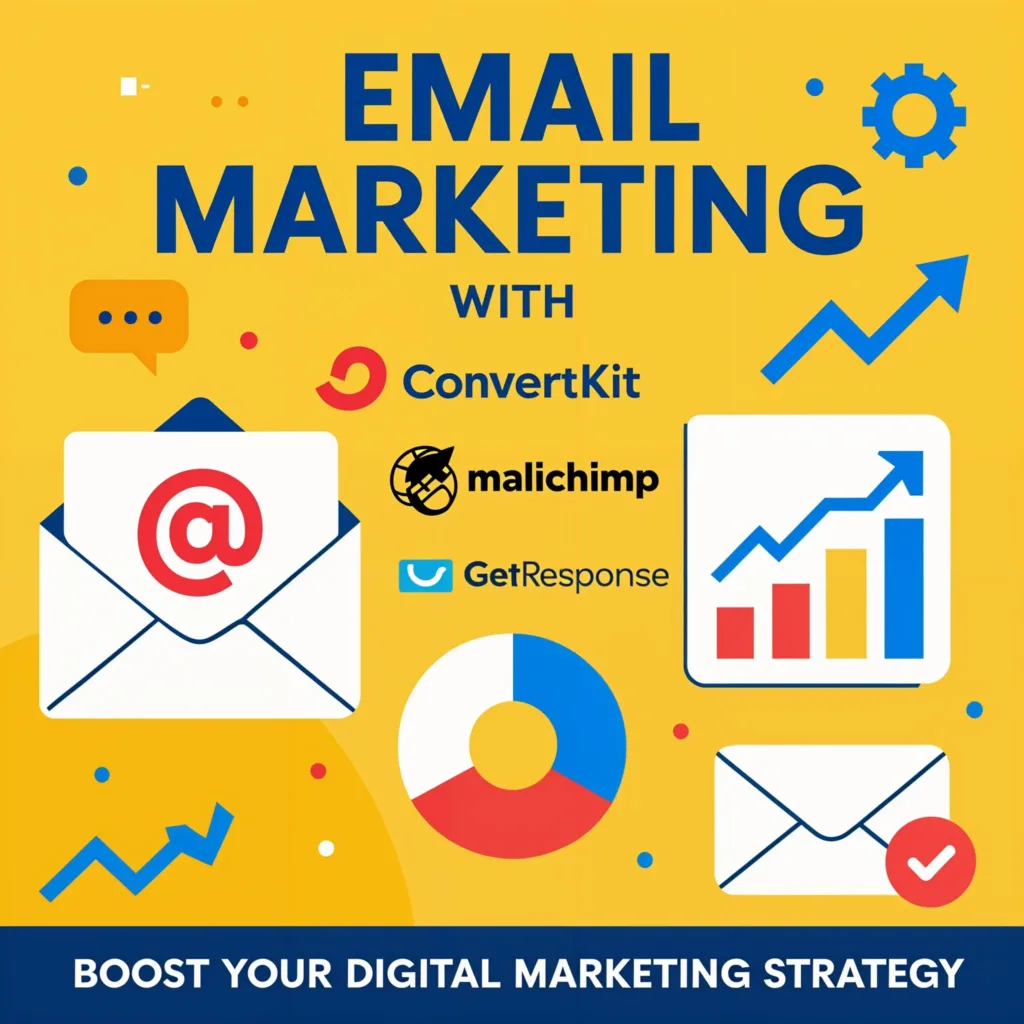
Introduction: Choosing the Right Email Tool Can Make or Break Your Business
ConvertKit vs Mailchimp vs GetResponse—this is one of the most common dilemmas entrepreneurs face when it comes to growing an online business. Email marketing is still king in 2025. It’s personal, high-converting, and allows complete ownership over your audience. But here’s the challenge—there are so many platforms to choose from.
Each tool claims to be the best. Yet depending on your business model, tech experience, and budget, the ideal platform for you might be very different. That’s why, in this blog, we’ll take a deep dive into the core features, pros, cons, and best use cases for each platform. By the end, you’ll know which platform suits your business goals best.
ConvertKit vs Mailchimp vs GetResponse: A Quick Overview
All three platforms—ConvertKit, Mailchimp, and GetResponse—offer powerful tools for email marketing. However, their focus and features are tailored to slightly different users.
- ConvertKit is designed with content creators in mind. It’s clean, intuitive, and excellent for automation.
- Mailchimp offers a broader set of tools including CRM and templates, making it great for small businesses.
- GetResponse is a powerhouse for automation and webinars, favored by marketers who want more advanced tools.
Before choosing, consider what your business really needs: simplicity, design flexibility, advanced automation—or all of the above.
Ease of Use: Which One’s Beginner-Friendly?
Let’s start with user experience. For beginners, ease of use is everything. You shouldn’t have to spend hours watching tutorials just to send your first email.
- ConvertKit: Known for its minimalistic interface. Even total beginners find it easy to build automation and create forms. There are no flashy visuals, but it’s smooth and uncluttered.
- Mailchimp: Offers drag-and-drop email builders and a visually appealing dashboard. However, with all the added features, it can get a bit overwhelming for new users.
- GetResponse: A mix of simple and complex. The dashboard is clean, but the features can be too advanced if you’re just starting out.
So, in the battle of ConvertKit vs Mailchimp vs GetResponse, if you want a tool that gets you going fast without a learning curve, ConvertKit is the winner.
Automation & Features: Who Offers the Best Workflow?
Automation is what sets average marketers apart from profitable ones. You want email sequences, triggers, tags, and smart segmentation—all working in the background.
- ConvertKit: Offers visual automation workflows and conditional triggers. It’s incredibly simple to set up onboarding, sales sequences, and nurture campaigns.
- Mailchimp: Offers decent automation, but its full potential is unlocked only in higher-tier plans. The builder isn’t as visual, and automations may feel limited in complexity.
- GetResponse: This is where GetResponse shines. You get advanced automation workflows, scoring, tagging, and even automation tied to webinar actions.
If you’re serious about segmenting, triggering actions, and creating behavioral-based flows, GetResponse takes the lead in this round.
Pricing Comparison: Which Platform Is More Affordable?
Budget always plays a role when choosing your email marketing tool. Especially when you’re scaling or just starting out.
- ConvertKit: Free for up to 1,000 subscribers with basic features. Paid plans start at $15/month. Great value for creators.
- Mailchimp: Free for up to 500 contacts but ads are included. Pricing increases quickly as your list grows.
- GetResponse: No free plan, but pricing starts at $19/month. However, it packs a lot more features per dollar.
While Mailchimp appears more affordable, its prices rise steeply as you scale. ConvertKit remains the most cost-effective for lean startups. However, GetResponse offers the best value per feature if you need landing pages, webinars, and advanced automation all in one.
Templates, Landing Pages & Forms: Who Has More Creative Control?
For entrepreneurs, lead generation is vital. So let’s compare form builders, landing pages, and templates.
- ConvertKit: Simple landing page and form builders with limited design flexibility. Best for those who don’t want to over-design.
- Mailchimp: Comes with dozens of email templates and well-designed landing pages. Ideal for small ecommerce or creative businesses.
- GetResponse: Offers a full landing page editor, pop-up tools, and webinar sign-up forms. It also has a built-in website builder for those who need more.
So, in terms of creative freedom and multi-purpose design, GetResponse offers more flexibility than both ConvertKit and Mailchimp.
Analytics & Reporting: Which One Helps You Improve?
Tracking your email performance is crucial. You need to know what’s working, what’s not, and why.
- ConvertKit: Offers basic reports—open rates, click rates, and unsubscribes. Enough for creators but not deep analytics.
- Mailchimp: Has solid reporting features, with visual graphs, benchmarking, and engagement breakdowns.
- GetResponse: Offers detailed analytics, including ROI tracking, webinar stats, and conversion funnels.
When comparing ConvertKit vs Mailchimp vs GetResponse, if deep analytics are a must, GetResponse gives you the most actionable data.
Who Should Use Which? Final Breakdown
Let’s make this simple with a quick reference for choosing:
- Use ConvertKit if you’re a content creator, coach, or solo founder who values simplicity, automation, and storytelling-based marketing.
- Use Mailchimp if you run a local business or ecommerce store and want easy design templates with broader tools.
- Use GetResponse if you want a powerful all-in-one platform with advanced automation, webinars, and landing page tools.
All three platforms are excellent—but your choice should reflect your business goals, growth stage, and technical comfort.
Conclusion: ConvertKit vs Mailchimp vs GetResponse—Make the Smart Choice
Choosing between ConvertKit vs Mailchimp vs GetResponse comes down to this: What do you really need to grow in 2025?
If you need quick setup, email-first simplicity, and automation for creators—go with ConvertKit.
If you want attractive emails and already run an ecommerce brand—Mailchimp is your friend.
And if you’re aiming for serious automation, webinar integration, and scalable marketing—GetResponse will deliver.
No matter your choice, the key is to pick a platform that supports your growth—not just today but into the future. Because email isn’t just about sending messages—it’s about building relationships that convert.